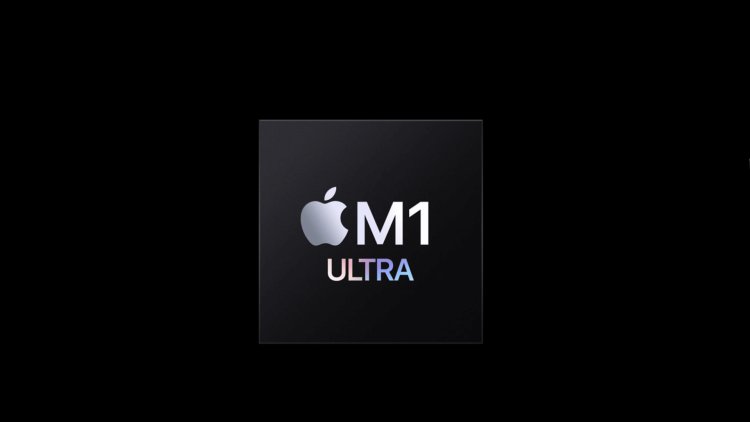Apple Introduces M1 Ultra Chip

Instead of M2 generation Apple processors, Apple simply merged two M1 Max chips into one, "new" - M1 Ultra
Just when you thought the Max suffix was the furthest Apple would go with its generation of processors, we got the Ultra version, essentially two, until yesterday the strongest M1 Max chip merged into one big one.
Given that the new chips are physically connected by a special bus, it is clear that Apple has planned this from the start, and that this is not a move that was decided at the last minute.

UltraFusion
The connection of two M1 Max chips is possible thanks to the new Apple UltraFusion architecture with a fast 2.5 TB / s internal bus, thanks to which this connection is possible without much delay. Also, this interface allows the system to see the two new connected chips as one, which drastically simplifies software data processing, without additional logical support for job reallocation.
In essence, Apple has managed to merge the two processors and eliminate all the negative consequences that occur in the process: additional delays and optimization of operating system performance.
What we got is an M1 Ultra chip with 20 CPU cores (16 fast and 4 energy saving), 64 GPU cores, and 32 Neural Engine cores in charge of artificial intelligence jobs. As icing on the cake comes support for a massive 128GB of RAM, which is a major shift for Apple processors.

Stronger than anything, take their word for it
According to their testing, Apple claims that the M1 Ultra has 8 times stronger performance than the regular M1 chip, which we saw in the new iPad Air tablet.
As always, Apple has some very bold claims for its new processors, accompanied by some very vague charts, with very scanty scales and weird comparisons.
The most powerful discrete GPU
One of those claims is that CPU performance is better than a 16-core desktop PC with 100W less power consumption, of course without a specific processor and without accurate power consumption to compare.
The more problematic statement is related to GPU performance, which says that the performance of the integrated graphics processor in the M1 Ultra chip is comparable to the " strongest discrete GPU " with 200 W lower consumption.
Of course, Apple again does not mention which GPU they consider discrete GPU ”, but we will assume that it is NVIDIA RTX 3090.
The problem with the RTX 3090 is that this graphics has 10,496 CUDA cores available, deployed in 82 streaming multiprocessors, and the M1 Ultra has 8,192 executable units that can be compared to CUDA cores, so the spear will break on the efficiency of individual actuators, but o only when the first tests come out.

With 114 billion transistors, the M1 Ultra is one of the most densely packed chips in the world. Add to that the support for 128 GB of RAM and it is clear that this new processor is intended for some very serious jobs. One of the biggest advantages of the new chip, its ability to see the system as a single processor, is in synergy with macOS, which is optimized to work with new chips, and which maximizes their potential. Unfortunately, this cannot be done by anyone else unless Microsoft starts production of its processors or AMD or Intel introduces its new operating system.
Who is the M1 Ultra for?
The second part of the presentation was focused on Mac Studio, a new line of small computers, which will feature a fresh M1 Ultra chip. It is a mini-desktop, which starts at $ 1,999 with an M1 Max chip, 32 GB of memory, and a 512 GB SSD, or $ 3,999 with an M1 Ultra chip, 64 GB of memory, and 1 TB of fast storage.
While at the very top of Apple's offer until today was the Mac Pro series of desktop computers, from today it is Mac Studio. Although they look like Mac Mini computers, Mac Studio packs serious hardware into a very small aluminum case for today's desktop computers.
In addition to the powerful interior, Apple has a wide selection of connections. There are 4 Thunderbolt ports, 10 Gb / s LAN, two USB A ports, HDMI, and a 3.5 mm headphone jack. Next are two additional USB-C ports (3.2 gen 2) which are on the model with M1 Ultra - Thunderbolt 4, four times higher transfer speeds, as well as a slot for SD cards.
Mac Studio computers will support as many as four 4K Pro Display screens, which is enough for even the most demanding content creators.
Among the new performance announcements, Apple boasts that the Mac Studio version with M1 Max processor has 50% better CPU performance than the Mac Pro with a 16-core Xeon processor, or two and a half times better performance than the 27-inch iMac desktop computer with 10- core Core i9 processor.

Studio Display
The ideal pair for a Mac Studio computer is the new Apple Studio Display 27-inch external monitor. It has narrower edges, an aluminum housing, and a stand that allows a 30-degree tilt, with an optional (more expensive) stand for more freedom of adjustment. It is a 5K Retina screen with a brightness of 500 nits and support for TrueTone, and an additional anti-reflective layer for better display.
What is especially interesting about this model is that it has an A13 Bionic chip, but also a 12 MP camera that we saw with the iPad Air model, with Center Stage support for better video calls. There are also three studio-class microphones and as many as six speakers, four of which are subwoofers with surround audio effects and Dolby Atmos support. Watch the entire conference in case you missed something:
Connectivity is a special story: 3 USB-C ports of 10 Gb / s and one Thunderbolt 4 port for easy connection and 96 W of power to charge any laptop like MacBook Pro - all via one cable.
The Studio Display comes with a price tag of $ 1,599 and will be available with Magic peripherals, in tune with the screen case and Mac Studio PC.





























